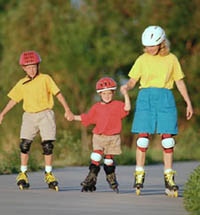Bicycle, In-Line Skating, Skateboarding Safety--Injury Statistics and Incidence Rates

The following statistics are the latest available from the National SAFE KIDS Campaign, the National Highway Transportation Safety Administration, and the American Academy of Pediatrics:
Injury and death rates:
More than 3.5 million children 14 and under suffer medically treated sports injuries each year.
Brain injury is the leading cause of sports-related death in children.
Motor vehicles are involved in the majority of bicycle-related fatal crashes.
Where and when:
Most child and adolescent bicycle crashes occur between May and August and between the hours of 3 p.m. and 6 p.m.
The majority of child and adolescent bicycle-related fatalities occur on minor roads, typically within one mile of the home.
When children and adolescents ages 14 and under ride their bicycles after sunset, they are four times more likely to be injured.
The majority of bicycle-related fatal crashes (80 percent) among children and adolescents ages 14 and under occur because of the bicyclist's behavior, such as riding into the street without stopping, swerving into traffic, running stop signs, or riding against the flow of traffic.
Who:
The majority of children (70 percent) between the ages of 5 and 14 years ride bicycles.
Children ages 14 and under are five times more likely to sustain injuries in a bicycle-related crash than any other age group.
Any child who rides without a bicycle helmet increases his or her risk of sustaining a head injury in a crash, and increases the risk of being involved in a fatal crash by 14 times.
Children under age 10 are at higher risk of serious injury, including head injuries.
Helmets:
Only up to 25 percent of children ages 14 and under use bicycle helmets, although statistics show the helmet can drastically reduce the risk of death and injury and the severity of injury. Bicycle helmets should also be used when riding scooters.
Bicycle helmets can reduce the risk of a head injury by 85 percent and brain injury by 88 percent.
Children between the ages of 11 and 14 reportedly are least likely to use a bicycle helmet (11 percent).
Children whose helmets fit poorly are twice as likely to sustain a head injury in a bicycle crash than children whose helmets fit properly.
Connect with us:
Download our App: